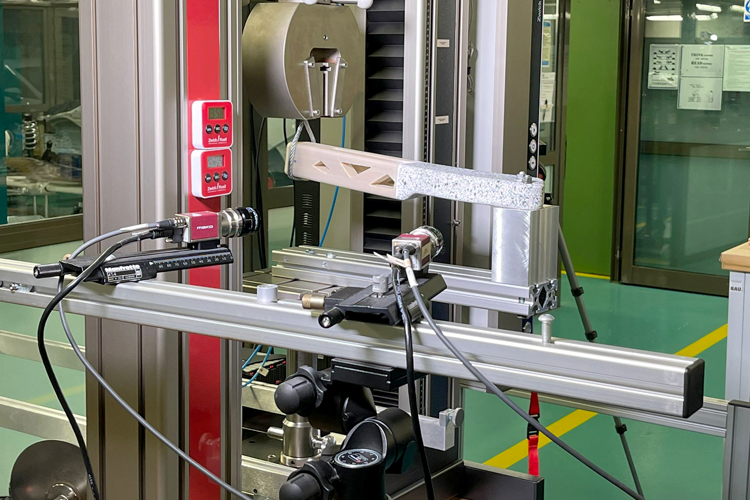Researchers from IQS have participated in the TRANSPORT project, leading the development and optimization activities of “lattice” type structures to achieve lighter parts through 3D printing, thus providing knowledge and experience in the field of additive manufacturing.

3D printed and topologically optimized structural element. Subjected to a load test.
TRANSPORT has been accredited as one of the projects within the RIS3CAT-Llavors3D strategy, supported by the Government of Catalonia as a research and innovation strategy for intelligent specialization in Catalonia, where 3D printing is a key player and a clear example of cross-cutting and innovative technology. The project has recently concluded and has involved both companies in the transport sector and university and research centres such as IQS.
The main objective of TRANSPORT has been the implementation and adoption of additive manufacturing (AM/3DP) in the rail transport industry, where vehicles are very heavy and it is necessary to make certain parts lighter through the introduction of new materials. A series of tasks were proposed to achieve seven demonstrators made with 3D printing, for parts commonly used in rail transport wagons, for passenger comfort, or to protect wagon systems, all of which are made with polymeric materials or aluminum alloys. For each demonstrator, a design, modeling, manufacturing, and experimental validation roadmap was defined, with hardness tests, finishes, and so on.
IQS participation
Researchers from the Industrial Products Engineering Group (GEPI) and the Materials Engineering Group (GEMAT) from IQS School of Engineering have contributed their experience and knowledge in the field of additive manufacturing (AM/3DP), led by Dr Guillermo Reyes. They have participated and collaborated in all tasks that fall under the TRANSPORT project, such as: definition of specifications, parts design, study and selection of materials, consolidation processes, finishing processes, and verification and validation tests.
It should be noted in particular that the IQS group led the “Definition of design tool requirements” task as part of the prior definition of specifications actions. Moreover, IQS has led two of the proposed tasks: “Development of numerical models for the simulation of lattice parts manufactured by AM/3DP” and “Optimization of lattice-type functional structures” as part of the design activity.
Within the “Optimization of lattice-type structures” task, IQS researchers have also been responsible for preparing the corresponding deliverable (or documentation of the results methodologies): Optimization of lattice structures to lighten parts, in which the methodology to modify the design of parts using AM is described along with how this type of design changes compared to traditional manufacturing processes.
The results obtained have produced various publications123 in specialized journals.
Lattice structures
Lattice structures have been used since the ancient civilizations of Egypt and Greece. Their use increased with the rise of the first industrial revolution, but slowed down due to the difficulty of obtaining them by traditional manufacturing methods (subtractive and conformative) and due to the high cost associated with them. Additive manufacturing has made it possible to manufacture complex geometries with a technological difficulty similar to that of generating solid volumes of material. Consequently, there has been significant growth in its use for lightweight components.
The term lattice refers to cellular design materials – a material that requires a volume inside (creating holes where it is not needed) – that form a three-dimensional geometry of structures with bars interconnected by nodes. These lattices are often used in AM applications to harden a thin surface, known as the skin, or to fill a volume. Its production has been made possible by the recently created nTop Platform software to respond to the need to numerically and geometrically model these materials for AM applications.

1 Role of infill parameters on the mechanical performance and weight reduction of PEI Ultem processed by FFF. Forés-Garriga, A., Pérez, M.A., Gómez-Gras, G., Reyes-Pozo, G., Materials and Design, 2020, 193, 108810.
2 Mechanical study on the impact of an effective solvent support-removal methodology for FDM Ultem 9085 parts. Chueca de Bruijn, A., Gómez-Gras, G., Pérez, M.A. , Polymer Testing, 2020, 85, 106433.
3 Experimental study on the accuracy and surface quality of printed versus machined holes in PEI Ultem 9085 FDM specimens. Gómez-Gras, G., Pérez, M.A., Fábregas-Moreno, J., Reyes-Pozo, G., Polymer Testing, 2020, 85, 106433.










